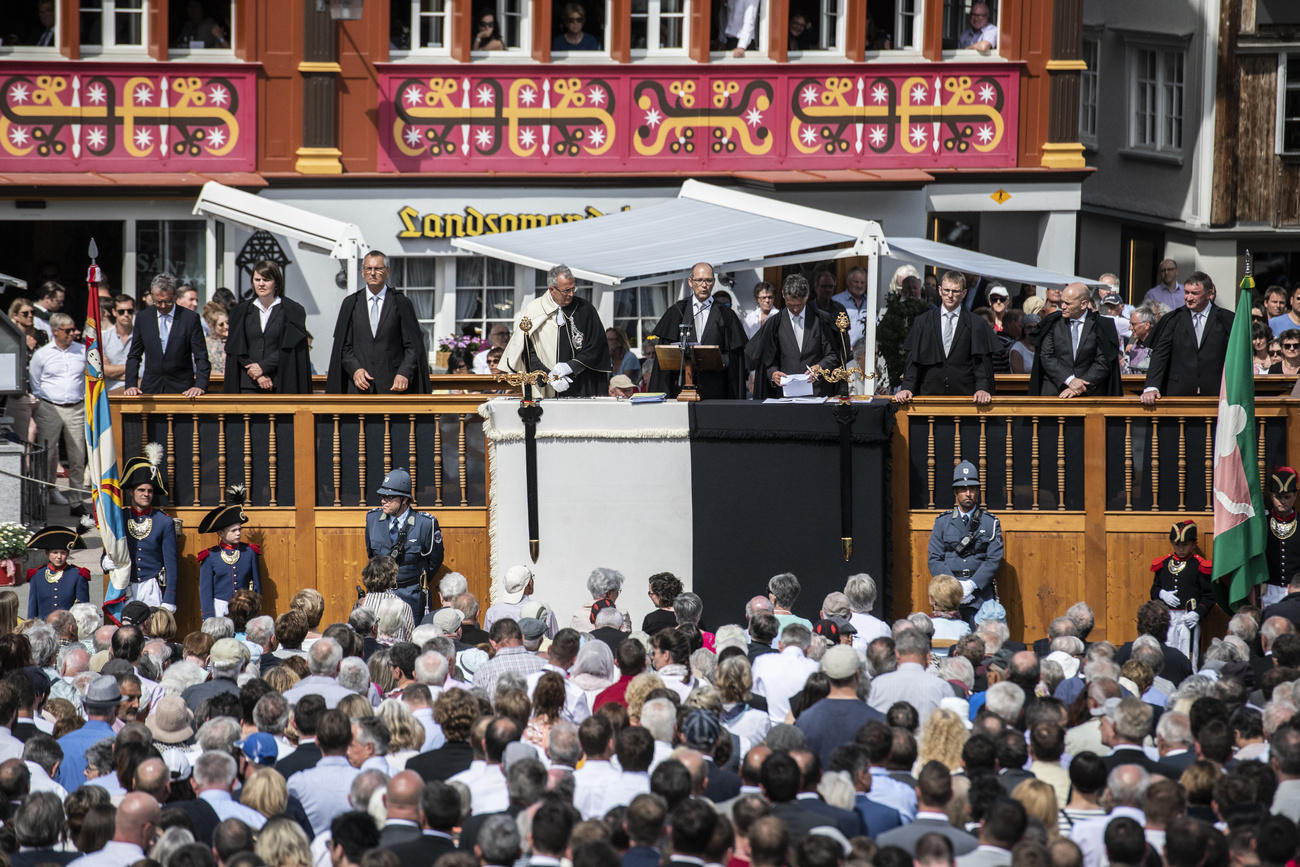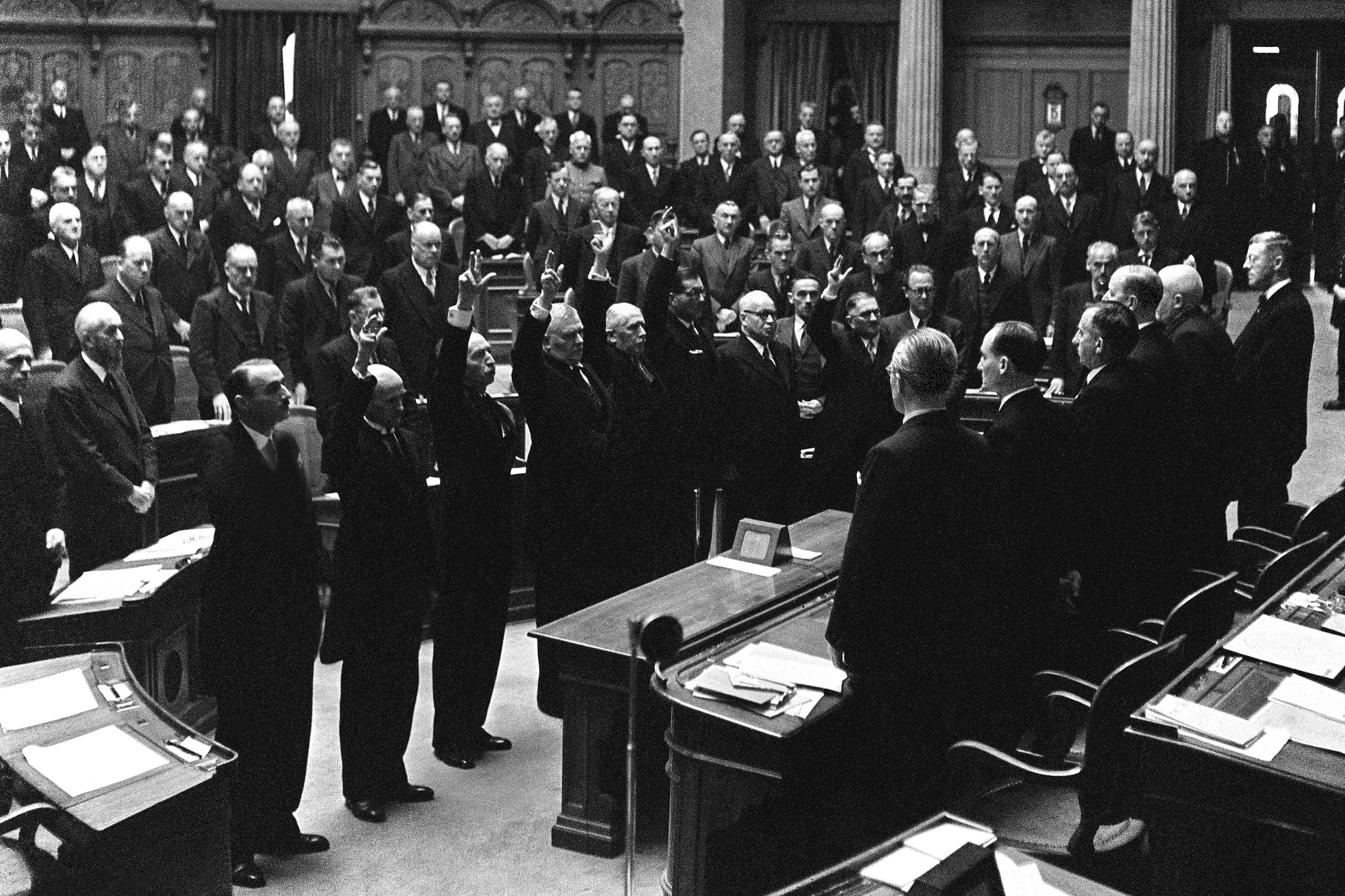The perfect democracy does not exist – not even in Switzerland
Many Swiss pride themselves on having the oldest and best democracy in the world. The research community provides a more nuanced perspective.
Contrary to common assumptions, democracy was not invented by the ancient Greeks. The Greek system was merely a local episode, whereas global history teaches us that modern democracies are the result of revolutions spreading gradually across the world.
The first wave of democratisation occurred in the 19th century, beginning in the United States in 1828 and ending in Italy nearly 100 years later, in 1922.
The second cycle, which lasted from 1943 to 1962, then included the democratisation of authoritarian regimes in Germany, Italy and Japan. The decolonisation of Jamaica from British rule marked the end of this phase.
The third wave, which was initiated by Portugal’s so-called Carnation Revolution in 1974, affected countries in south-eastern Europe as well as in Latin America, notably Costa Rica and Uruguay. This phase has not yet ended, say some experts. Others reckon it came to an end with the collapse of the Soviet Union in 1989, which led seamlessly into the latest cycle – a cycle that saw democracies spring up in eastern Europe and Asia, with Taiwan being a recent example.
In this context, experts have often referred to liberal democracies shaped according to the British model, defined by government versus opposition, democratic political parties and interest groups acting within a market economy.
To this day no other political system has been more successful.
Different systems
Switzerland’s gradual democratisation began during the first wave, both at a local level in canton Ticino, in 1830 and at a national level in 1848.
As there were hardly any role models in the early phase of democratisation, different systems were tried:
• The US established a presidential democracy with a president replacing a king or queen as head of state.
• Under the British system, the powers of the monarchy were restricted by a parliamentary democracy.
• Switzerland followed the example of neighbouring France after its 1789 revolution and based its democracy on republican ideas.

More
Shared political power makes citizens happier
But the Swiss democracy remained incomplete compared with the strict government-opposition set-up of the Anglo-Saxon world. There was no regular switching of power between the Liberal majority and the Catholic Conservatives or the left-wing opposition. Up to 1919 the Liberals (and later the Radicals) won all parliamentary elections mainly because of the so-called first-past-the-post system and gerrymandering.
Consensus model
This chapter in Swiss history was only closed when proportional representation was introduced for elections to the House of Representatives and when constituencies were rearranged along the model of the 26 cantons.
The electoral reform spelled the end of the Radical Party’s dominance in parliament. From then on, the party of the founding fathers of modern-day Switzerland had to rely on the support of the Christian Democrats (formerly Catholic Conservatives) and the People’s Party to push through its political demands.
But despite the overhaul, the Radicals and Liberals never lost their grip on power at a national level or – with a few rare exceptions – in the cantons. Instead, the permanent participation of all the major political parties, including the left-wing Social Democrats, established the consensus democracy model at a national level, with all being represented in government according to their approximate electoral strength.
In other words, the Radicals (including the Liberals) have been in power for 172 years in Switzerland – a record achieved in no other democracy.
Initiatives and referendums
Switzerland also developed a unique feature for its democracy in the last few decades of the 19th century, by allowing the possibility to challenge parliamentary decisions (with so-called referendums, introduced in 1874) and to change the Swiss constitution (with people’s initiatives, introduced in 1891).
This made Switzerland a pioneer in democracy at the time.
But before the end of the century, New Zealand took over the role of democratic front-runner, adopting an amended constitution in 1894 that included participatory rights and women’s suffrage; it took Switzerland until 1971 to grant its female citizens full civic rights at a national level.
What’s more: it has to be said that apart from its direct democracy, Switzerland has ceased to be a democratic role model.
More information:
Democratic shortcomings?
The Anglo-Saxon theory of democracy even hesitates to accept the Swiss consensus democracy model as a legitimate alternative to majoritarian “competitive” democracy.
Critics recognise that modern-day Switzerland succeeded in integrating its farmers and workers into society after 1848. But they point at the lack of competition among the different groups vying for political power – that is, the quasi hegemonic rule of the Radicals and Liberals.
Another factor drawing criticism is the lack of accountability of the government in Switzerland. According to the Anglo-Saxon model, citizens must have the right to vote out an executive body which has failed to deliver and to elect a new regime.
The 2019 Swiss parliamentary elections help illustrate this point. In October, all four parties represented in the government suffered a drop in voter support, mainly due to the gains of two Green parties who are not represented in the seven-member government.
Nevertheless, the party-political make-up remained unchanged – virtually impossible in another democratic country.
The modern, more globalised research community is less severe with the Swiss-style model of consensus democracy. It is now widely accepted that there is no single model democratic system, and that representative (parliamentary) democracies also have major flaws.
To mention just four cases in Europe and the US:
• The electoral system in Britain has blocked political changes for too long.
• The president in France has disproportionate powers that are not legitimated by the population.
• Germany has been beating about the bush for a long time to prepare for an expected change of government.
• In other democracies, including the US, Italy or Hungary, democratically elected autocratic presidents with authoritarian powers or populist parties have restricted basic rights.
Priority principles
The latest democracy research project by the Swedish university of GothenburgExternal link does not abandon of a liberal democracy as the majority principle and rule of law go together. In its novel approach, researchers give priority to how democratic values are implemented and revaluate purely institutional aspects.
The key principles include freedom and equality, public access and participation, all seen as preconditions for fair and meaningful elections. Without these values we would see something like an electoral democracy without liberal principles.
The Swiss democratic system was embedded in a context of liberal principles when modern-day Switzerland was founded in 1848. But only in 1971 did the country became a liberal democracy when it extended voting rights to women.
The novel research approach is the reason why Switzerland moved up to fifth position in last year’s democracy ranking by the Gothenburg political scientists. The country came top in offers for participation but did not excel when it came to equality.
Adapted from German/urs

In compliance with the JTI standards
More: SWI swissinfo.ch certified by the Journalism Trust Initiative












You can find an overview of ongoing debates with our journalists here . Please join us!
If you want to start a conversation about a topic raised in this article or want to report factual errors, email us at english@swissinfo.ch.